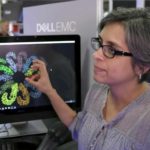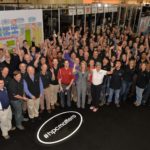Sadasivan Shankar gave this Invited Talk at SC16. “This talk will explore six different trends all of which are associated with some form of scaling and how they could enable an exciting world in which we co-design a platform dependent on the applications. I will make the case that this form of “personalization of computation” is achievable and is necessary for applications of today and tomorrow.”
Co-Design 3.0 – Configurable Extreme Computing, Leveraging Moore’s Law for Real Applications
Video: Advances and Challenges in Wildland Fire Monitoring and Prediction
Janice Coen from NCAR gave this Invited Talk at SC16. “The past two decades have seen the infusion of technology that has transformed the understanding, observation, and prediction of wildland fires and their behavior, as well as provided a much greater appreciation of its frequency, occurrence, and attribution in a global context. This talk will highlight current research in integrated weather – wildland fire computational modeling, fire detection and observation, and their application to understanding and prediction.”
Thomas Sterling Presents: HPC Runtime System Software for Asynchronous Multi-Tasking
Thomas Sterling presented this Invited Talk at SC16. “Increasing sophistication of application program domains combined with expanding scale and complexity of HPC system structures is driving innovation in computing to address sources of performance degradation. This presentation will provide a comprehensive review of driving challenges, strategies, examples of existing runtime systems, and experiences. One important consideration is the possible future role of advances in computer architecture to accelerate the likely mechanisms embodied within typical runtimes. The talk will conclude with suggestions of future paths and work to advance this possible strategy.”
Video: The Materials Project – A Google of Materials
“The Materials Project is harnessing the power of supercomputing together with state-of-the-art quantum mechanical theory to compute the properties of all known inorganic materials and beyond, design novel materials and offer the data for free to the community together with online analysis and design algorithms. The current release contains data derived from quantum mechanical calculations for over 60,000 materials and millions of properties.”
Memory Bandwidth and System Balance in HPC Systems
“This talk reviews the history of the changing balances between computation, memory latency, and memory bandwidth in deployed HPC systems, then discusses how the underlying technology changes led to these market shifts. Key metrics are the exponentially increasing relative performance cost of memory accesses and the massive increases in concurrency that are required to obtain increased memory throughput. New technologies (such as stacked DRAM) allow more pin bandwidth per package, but do not address the architectural issues that make high memory bandwidth expensive to support.”
Video: How GPUs are Remaking Cloud Computing
In this video from the Nvidia Booth at SC16, Jonathan Symonds from MapD presents: How GPUs are Remaking Cloud Computing. “This video discusses how price/performance characteristics of GPUs are changing the nature of cloud computing. The talk includes performance benchmarks on Google Cloud, Amazon Web Services and IBM Softlayer as well as a live demonstration.”
Podcast: Intel Doubles Down on Artificial Intelligence
In this Chip Chat podcast, Diane Bryant, EVP/GM for the Data Center Group at Intel, discusses how the company is driving the future of artificial intelligence by delivering breakthrough performance from best-in-class silicon, democratizing access to technology, and fostering beneficial uses of AI. Bryant also outlines her vision for AI’s ability to fundamentally transform the way businesses operate and people engage with the world. In a blog Krzanich said: “Intel is uniquely capable of enabling and accelerating the promise of AI. Intel is committed to AI and is making major investments in technology and developer resources to advance AI for business and society.”
SC16 Applies Advanced Computing for Social Change
In this video, Dr. Kelly Gaither from TACC describes how 20 students identified by XSEDE’s community engagement team participated in a four-day long cohort experience themed around social change at SC16. “The objectives of the program are to engage students in a social change challenge using visualization and data analytics to increase awareness, interest, and ultimately inspire students to continue their path in advanced computing careers; to increase the participation of students historically underserved in STEM at SC.”
CryoEM Demo on Dell PowerEdge C6320 at SC16
In this video from SC16, Garima Kochhar from Dell EMC describes the CryoEM Demo on the Dell PowerEdge C6320 rack server powered by Intel Xeon and Intel Xeon Phi. “This demo presents performance results for the 2D alignment and 2D classification phases of the Cryo-electron microscopy (Cryo-EM) data processing workflow using the new Intel Knights Landing architecture, and compares these results to the performance of the Intel Xeon E5-2600 v4 family.”
Building SCinet at SC16: The World’s Fastest Network
In this time-lapse video, a team of volunteers build the SCinet, the world’s fastest network at SC16. “Created each year for the conference, SCinet brings to life a very high-capacity network that supports the revolutionary applications and experiments that are a hallmark of the SC conference. SCinet links the convention center to research and commercial networks around the world. In doing so, SCinet serves as the platform for exhibitors to demonstrate the advanced computing resources of their home institutions and elsewhere by supporting a wide variety of bandwidth-driven applications including supercomputing and cloud computing.”













